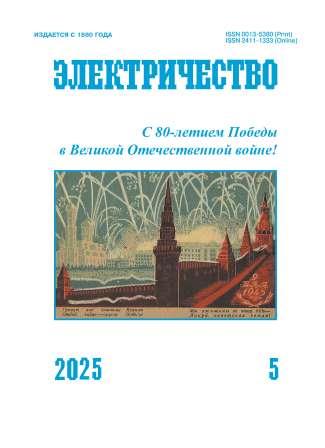Determination of the Effect of Partial Shading on the PV Module Performance by Its Volt-Ampere Characteristic
DOI:
https://doi.org/10.24160/0013-5380-2025-5-55-61Keywords:
photovoltaic module, partial shading, shunt diodes, volt-ampere characteristicAbstract
An important objective pursued in the operation of photovoltaic modules is to reduce the influence of shading on the energy conversion efficiency. The majority of modern approaches used to solve the problem are based on the use of shunt diodes built in the module design. With such solution, it becomes possible to provide an alternative path of current flow between unshaded solar cells, thereby preventing their overheating. The article presents classification of the main faults of shunt diodes that are encountered. The article addresses an analysis of the volt-ampere characteristic type for different cases of 95 % shading of cells. The novelty of the study lies in the method for a comparative analysis of values corresponding to the points of maximum power and short-circuit current with the values of the control volt-ampere characteristic built without taking into account the shading in normal operation mode with applying the IV Swinger 2 software system. The response of a PV module to partial shading of its cells in the urban environment of the city of Chelyabinsk is considered. By using the obtained volt-ampere characteristics, the extent to which the generated power is reduced under different conditions can be traced. The shading of even one cell may reduce the efficiency by as much as 31 %. The study presented contributes to the discussion of matters concerned with optimizing the performance of PV modules and highlights the importance of using volt-ampere characteristics as the main tool to analyze the module operation efficiency. The study results help to get a better insight in how the shading affects the module performance and develop new solutions to ensure normal operation under different environmental conditions.
References
2. Кирпичникова И.М., Серов В.А. К вопросу решения проблемы загрязнения солнечных модулей. – Энергосбережение и водоподготовка, 2024, № 2 (148), с. 42–50.
3. Lin L. et al. Influence of Outdoor Conditions on PV Module Performance – an Overview. – Material Science & Engineering International Journal, 2023, vol. 7, iss. 2, pp. 88–101, DOI: 10.15406/mseij.2023.07.00210.
4. Lee S. Avoid Solar Panel Shading: How to Minimize Its Impact [Электрон. ресурс], URL: https://www.velosolar.com/solar-panel-shading/ (дата обращения 05.03.2025).
5. Masters G. Wind Power Systems. – Renewable and Efficient Electric Power Systems, 2004, pp. 307–343, DOI: 10.1002/0471668826.ch6.
6. Кирпичникова И.М. и др. Анализ видов деградации фотоэлектрических модулей и их вольт-амперных характеристик. – Вестник ПНИПУ. Электротехника, информационные технологии, системы управления, 2024, № 51, с. 176–200.
7. Khodapanah M. et al. Partial Shading Detection and Hotspot Prediction in Photovoltaic Systems Based on Numerical Differentiation and Integration of the P – V Curves. – IET Renewable Power Generation, 2023, vol. 17, iss. 2, pp. 279–295, DOI: 10.1049/rpg2.12596.
8. Ghanbari T. Permanent Partial Shading Detection for Protection of Photovoltaic Panels Against Hot Spotting. – IET Renewable Power Generation, 2017, vol. 11, iss. 1, pp. 123–131, DOI: 10.1049/iet-rpg.2016.0294.
9. International Energy Agency. Assessment of Photovoltaic Module Failures in the Field [Электрон. ресурс], URL: https://iea-pvps.org/key-topics/report-assessment-of-photovoltaic-module-failures-in-the-field-2017/# (дата обращения 05.03.2025).
10. Ahmad J. et al. Detection of Typical Defects in Silicon Photovoltaic Modules and Application for Plants with Distributed MPPT Configuration. – Energies, 2019, vol. 12, No. 23, DOI: 10.3390/en12234547.
11. Швец С.В., Байшев А.В. Назначение шунтирующих диодов солнечной панели и методы их диагностики. – Вестник Иркутского государственного технического университета, 2019, т. 23, № 6, с. 1187–1202.
12. Зиновьев В.В., Бартенев О.А. Исследование промышленных солнечных модулей в области прямой и обратной ветви вольт-амперной характеристики при частичном затенении. – Управление техносферой, 2019, т. 2, вып. 3, с. 265–281.
13. Özkalay E. et al. The Effect of Partial Shading on the Reliability of Photovoltaic Modules in the Built-Environment. – EPJ Photovoltaics, 2024, vol. 15, DOI: 10.1051/epjpv/2024001.
#
1. Kumari N. et al. Performance Investigation of Monocrystalline and Polycrystalline PV Modules Under Real Conditions. – IEEE Access, 2024, vol. 12, pp. 169869–169878, DOI: 10.1109/ACCESS.2024.3497318.
2. Kirpichnikova I.M., Serov V.A. Energosberezhenie i vodopod-gotovka – in Russ. (Energy Saving and Water Treatment), 2024, No. 2 (148), pp. 42–50.
3. Lin L. et al. Influence of Outdoor Conditions on PV Module Performance – an Overview. – Material Science & Engineering International Journal, 2023, vol. 7, iss. 2, pp. 88–101, DOI: 10.15406/mseij.2023.07.00210.
4. Lee S. Avoid Solar Panel Shading: How to Minimize Its Impact [Electron. resource], URL: https://www.velosolar.com/solar-panel-shading/ (Access on 05.03.2025).
5. Masters G. Wind Power Systems. – Renewable and Efficient Electric Power Systems, 2004, pp. 307–343, DOI: 10.1002/0471668826.ch6.
6. Kirpichnikova I.M. et al. Vestnik PNIPU. Elektrotekhnika, informatsionnye tekhnologii, sistemy upravleniya – in Russ. (Bulletin of PNRPU. Electrical Engineering, Information Technology, Control Systems), 2024, No. 51, pp. 176–200.
7. Khodapanah M. et al. Partial Shading Detection and Hotspot Prediction in Photovoltaic Systems Based on Numerical Differentiation and Integration of the P – V Curves. – IET Renewable Power Generation, 2023, vol. 17, iss. 2, pp. 279–295, DOI: 10.1049/rpg2.12596.
8. Ghanbari T. Permanent Partial Shading Detection for Protection of Photovoltaic Panels Against Hot Spotting. – IET Renewable Power Generation, 2017, vol. 11, iss. 1, pp. 123–131, DOI: 10.1049/iet-rpg.2016.0294.
9. International Energy Agency. Assessment of Photovoltaic Module Failures in the Field [Electron. resource], URL: https://iea-pvps.org/key-topics/report-assessment-of-photovoltaic-module-failures-in-the-field-2017/# (Date of appeal 05.03.2025).
10. Ahmad J. et al. Detection of Typical Defects in Silicon Photovoltaic Modules and Application for Plants with Distributed MPPT Configuration. – Energies, 2019, vol. 12, No. 23, DOI: 10.3390/en12234547.
11. Shvets S.V., Bayshev A.V. Vestnik Irkutskogo gosudarstven-nogo tehnicheskogo universiteta – in Russ. (Bulletin of the Irkutsk State Technical University), 2019, vol. 23, No. 6, pp. 1187–1202.
12. Zinov’ev V.V., Bartenev O.A. Upravlenie tehnosferoy – in Russ. (Technosphere Management), 2019, vol. 2, iss. 3, pp. 265–281.
13. Özkalay E. et al. The Effect of Partial Shading on the Reliability of Photovoltaic Modules in the Built-Environment. – EPJ Photovoltaics, 2024, vol. 15, DOI: 10.1051/epjpv/2024001




